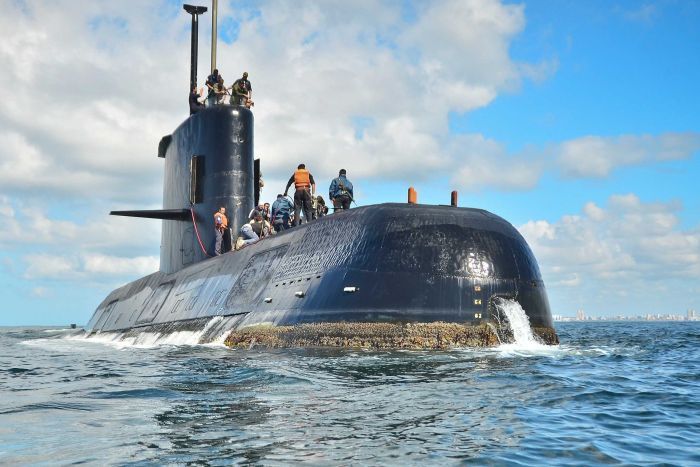Lost sub in Argentina
Article by journalist OM Marcin Marciniak – SP5XMI
The lost submarine near Argentina
We have heard many times that there is a need for two security circuits that operate on different principles. After the transition period the satellite communication took over all emergency channels except for short range that still works using VHF and to some extent also medium range using HF. We have heard about distress signal problems during the transition era but digital systems won the race by automation. The R/Os era is unfortunately gone. Let’s ask a question – is there anything left? Are there coast stations that still keep watch on HF? Does the crew know how to use the HF equipment in the satellite telephone era? Do they know and exercise CW communication? I think they don’t. The Russian Navy is one of the exceptions, maybe the US Navy could be another one. Incidents just happen and the satellite communication CAN break. And sometimes it breaks. Maybe the military vessels still have communication officer on board but do they have procedures?
The lost submarine
On 17th of November 2017 it was announced that Argentina’s TR-1700 class submarine ARA San Juan had not been heard from since 15th of November. A SAR operation was launched to search the area about 200 nm southeast of San Jorge Gulf but to no avail. A few hours ago AP press feed informed that Argentina’s Defence Ministry said there were seven failed satellite calls that were believed to come from a missing submarine. The calls could be a sign the 44-strong crew of the ARA San Juan was trying to re-establish contact. The calls lasted between four and 36 seconds in the late morning and early afternoon on Saturday (local time), the ministry said in an emailed statement. The satellite communications were believed to have failed because of foul weather, a source in the defence ministry who was not authorised to speak publicly told Reuters.
(information here: http://www.abc.net.au/news/2017-11-19/argentina-says-satellite-calls-detected-likely-from-submarine/9166324)
We had this before
Maybe this sea accident has something similar to m/v Prinsendam/PJTA emergency contacts via MF/HF where the satellite communication devices weren’t working due to heavy list.
Is there any way to communicate? I think there is but will they use it? The MF CW is already gone, nobody keeps watch so the oldest means is not available anymore. The HF is crippled as well. There are not so many coast stations on HF. Not all vessels have the HF gear ready, most stations just rely on satellites. The ship-ship rescue HF communication is crippled. Do they keep watch on 2182? The HF receivers have relatively poor performance and the DSC signal is nowhere near CW as far as energy efficiency is concerned. Right now radio amateurs have better receivers than almost all of the merchant navy vessels. The GMDSS radio receivers are on par with main receivers from 80s era set to medium bandwidth. Some former R/Os say the 90s gear was better due to good filtering and noise blankers. Right now the entry level amateur transceiver FT450D has better receiver than the gear that is intended to save life.
Will the amateurs help?
The radio amateurs issued an appeal for keeping watch on emergency frequencies including popular MF frequencies (416 kHz, 437 kHz, 500kHz) even if WE know that the sub doesn’t have the MF gear anymore (it was dismantled during the mid-life update in 2008). Anyway the sub still has HF radio with automatic antenna tuning. The well-known HF frequencies were listed as well – 2065kHz, 2182 kHz, 3023kHz, and 3860.6kHz, 4125kHz, 4143.6kHz, 6218.6kHz, 8528kHz too. The appeal was issued in Europe too, even if we know that receiving weak signal from South Atlantic near Argentina is not easy on such frequencies. The best way should be 10MHz by the grayline but the sub does not need to contact Europe. They need reliable medium range communication (up to 1000 miles) when the old frequencies should work better. Even in foul weather. Old-fashioned HF radio just works even if it’s not as fancy as space age technology with satellites.
Maybe it’s time to reinstitute the lifeboat’s HF radios and build a network of digital automatic coast stations connected by common high-speed fiberoptics? The simple lifeboat radio (RS-101, old Polish unit, pictured) was quite effective on 6 and 8MHz bands with long antenna deployed, some R/Os had QSOs over 500km during the day – all using technology from the 70s. Right now 20W on HF into a vertical with proper digital mode works very well for the amateurs. Maybe their experience can be used in professional communication to save life. To communicate at sea without satellites at all. Because satellites can break. And in the future they will.

On pictures – Jan Kupski with the RS-101 lifeboat radio,
73’s Marcin Marciniak SP5XMI
